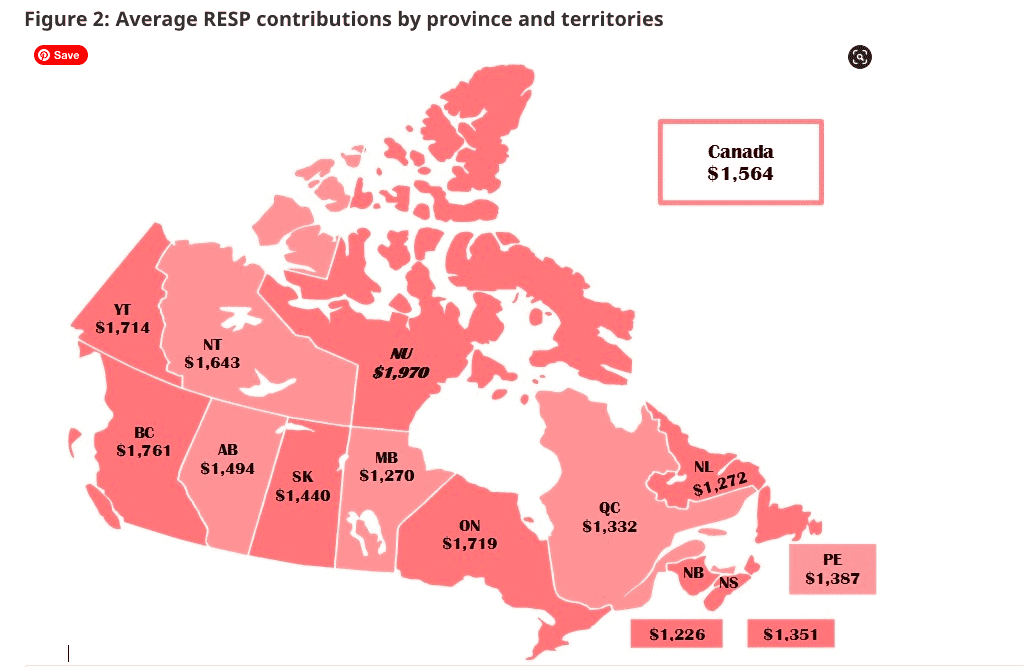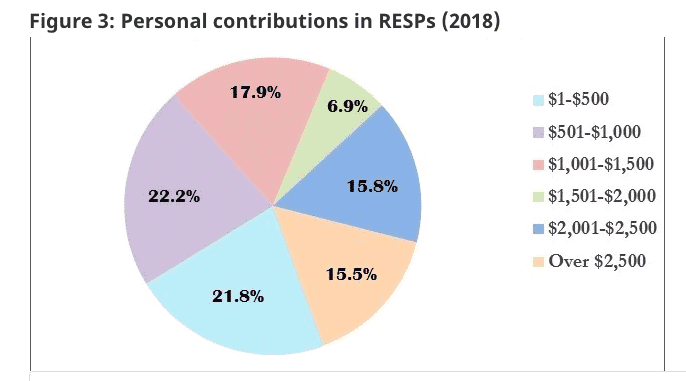Higher education is getting pretty expensive nowadays. With RESP, you can start saving early for your child’s future. The investments you make today will grow over time and the compounded effect will have massive gains by the time your kid grows up.
A lot of parents begin to plan for their kid’s educational futures as soon as they are born. An education savings account is opened on the kid’s behalf to help fund the ever-increasing cost of education.
A majority (56%) of Canadian parents appear to be leaving money on the table when it comes to saving for their children’s post-secondary education, according to a new Ipsos poll conducted on behalf of Knowledge First Financial.
Being able to afford any post-secondary education compels proper planning, investment, and forethought. This is why RESP is one of the best ways to go.

Source: canada.ca
What Is An RESP?
The Registered Education Savings Plan or RESP is a savings strategy set up by the Canadian government to assist parents in saving up for their child’s education.
Regular timely payments are made into the savings plan (RESP) by parents and also through additional grants by the Canadian government. And in order to protect the funds, RESP investment returns are shielded from taxes. (just like your RRSPs and TFSAs)
The idea is to make the savings grow as the child grows so that immediately after finishing high school, there are enough funds to further the child’s education.
Canadian students can expect to graduate with $27,000 (£15,792) debt based on a three-year program. International students who graduate from a Canadian university can expect to carry a debt burden of $75,540 (although some courses last for four years, in which case it will be more).
Adding up the government grants over the years, tax exemptions and the compounded growth of your investments, RESP can really grow into a substantial amount making sure your kid(s) finish their higher education with little or no debt.

Source: canada.ca
How Does An RESP Work?
Setting up an RESP on your child’s behalf can be done by anybody; be it the kid’s grandparents, parents, relatives, or family friends.
The individual in charge of opening and contributing to the RESP is known as the subscriber. And as a subscriber, you can have more than one beneficiary under the plan. Luckily for children, a child can also be the beneficiary to one or more RESP plan/s.
Moreover, RESP, unlike other saving plans, has one purpose and that’s paying for expenses associated with pursuing higher education.
Nearly six in ten (56%) say they have not taken advantage of various grants available within an RESP. Even half (50%) of parents of children aged 14 to 17 have not taken advantage of any grant program within an RESP.
To become eligible to earn the RESP, the individual must attend either a College, University, or a different educational institution in Canada. This is in accordance with the Canada Student Financial Assistance Act.
As a result of this, there are distinct rules associated with RESP especially when it comes to withdrawals. In general, tuition, books, transportation, and all other school-related expenditures are covered by the RESP.
RESP Types
Remember, every RESP is different.
-
some RESP types require specific monthly contributions
-
while others let you put money into your RESP account whenever you want.
The sooner you start to save (whichever RESP you choose), the sooner you will be earning interest, and the more your money will grow. (compounded effect).
Even savings of $10 a week can quickly add up, especially when the Government of Canada adds money to your savings.
There are three types of RESPs:
1. Individual RESP Plan
As part of the Individual RESP plan, only one beneficiary can be appointed. Anyone can open the account for anyone.
Ideal for:
-
Single child families.
-
Families with large age differences between children.
-
Subscribers who want to set up an RESP for themselves or someone they’re not related to.
2. Family RESP Plan
The family RESP can have more than one beneficiary attached to it. This is ideal for families with more than one kid.
Family RESP can be opened by parents or grandparents of the children and can be withdrawn in the name of any beneficiary named to the plan. Investment returns on savings can be shared by all beneficiaries.
Ideal for:
- Single-child families planning to have more children.
- Families with more than one child or planning to have more than one child.
- Families with more than one child as the government grants and income – with the exception of the Canada Learning Bond (CLB) – are shared by all beneficiaries in the plan.
3. Group RESP Plan
Group RESP plans are significantly different from both individual and family plans. They involve specific contribution schedules and tend to be much more restrictive, with higher fees and a plethora of rules.
Furthermore, With a group RESP, you have no control over the investments whatsoever. Instead, savings from many different investors are pooled together in a group, and your child shares in the pooled savings of investors with children of the same age.

How To Open an RESP Account?
Opening an RESP account for your child is actually quite simple. The best way to do it is to get in touch with either your credit union, bank, financial planner, or online broker and request to set up a self-directed RESP.
In order to open an account, you’ll be asked to submit documents such as your child’s Social insurance number (SIN number), your child’s birth certificate, and your own social insurance number (as the contributor). Upon providing the documents, and post-processing, as RESP account is opened for your kid without any further delays.
Make sure you ask your bank to set up auto deposits every month. This way you’ll end up saving every bi-weekly or monthly for your child’s education and future. Again, deposits can be how much you can afford at the moment. You can always increase the RESP deposit amount as you income increases or when you have more room to contribute. But do not delay in setting up the auto deposits.
I’ll recommend you link your bank’s chequing account to the RESP so that automatic withdrawals can be made each month.
You can start saving as little as $25 every month as everything eventually adds up but if you have the capacity, saving $200 and above monthly will set you on the right track.
RESP Providers
First of all, before we begin, what are RESP Providers? Let me explain.
When it comes to RESP providers, there are various options to consider. Factors such as fees and range of services should be evaluated when choosing an RESP provider.
A self-directed RESP however is still the simplest and cost-effective option out there. Some institutions offer the group RESP which is very conservative and runs on a higher cost.
The Canadian government has always encouraged early registration for infants in order to motivate more families to set up an RESP for kids. And as such parents can immediately get an RESP provider when enrolling for the kid’s social security number and birth certificate.
How To Contribute To an RESP?
RESP can be set up as soon as a child is born.
All that will be required of you to open an account is the child’s Social Insurance Number (SIN).
The unique feature of the RESP is the input from both you, the subscriber and the Canadian government. The Canadian government primarily contributes to your savings via education grants.
As the subscriber, there’s a lifetime limit of $50,000 on the contribution you can make for each child.
The Canadian government via the Canada Education Savings Grant (CESG), offers a grant of 20% up to a maximum of $2500 contributed by the subscriber. This implies that the Canadian government contributes a maximum of $500 annually.
The Canada Education Savings Grant (CESG) is a government grant given to those that contribute to an RESP. For every dollar you contribute to an RESP up to a maximum of $2500, the government will contribute 20 cents into your child’s RESP plan through CESG.
It isn’t mandated that you contribute $2500 each year as you can always roll over the unused CESG to the following year.
The Canada Education Savings Grant or CESG will be accessible until the year the child clocks 17.
Each child gets to earn a lifetime maximum of $7,200 through the CESG grant.
You can read everything about the CESG grant here. ( Official Canadian Government’s CESG link)
Apart from the CESG, the Canadian government further provides additional grants to middle-income and low-income households through:
1. Canada Learning Bond (CLB)
To help low-income households, as soon as a child is born an initial $500 through CLB is paid into the child’s RESP to help get the family started.
Subsequently, an extra $100 is granted every year until the child clocks 15. A household will earn a maximum of $2000.
2. RESP Provincial Grants
Specific provinces help provide extra grants alongside the general grants to motivate residents to save up and plan for their children’s schooling.
The British Columbia Training and Education Savings Grant is one such example from the BC Government.
3. Additional Canada Education Savings Grant
Any household with a net income of less than $93,208 is eligible for the additional CESG.
You can always go to the Government of Canada RESP page to find out more information.
The child can get more than $500 of CESG per year, up to a maximum of $1,000, under certain circumstances.
The subscriber can carry forward the unused amount of CESG from previous years by contributing more than $2,500 per year. This way, a child could get up to $1,000 in CESG per calendar year if there are unused amounts from previous years.
How To Get the RESP Grant from the government?
Generally, the application for the CESG grant is done by the RESP providers on your behalf. However, the duration of the application varies from one RESP provider to the other.
Most parents (88%) say it is important (55% very / 32% somewhat) that the grant application process is easy from an administration perspective, and more than eight in ten (82%) say it’s important (43% very / 39% somewhat) that they receive guidance and advice from an RESP specialist throughout the application process.
Ideally, it takes up to one or two months (after the provider must have applied) before the grant is deposited into your RESP account.
How To Withdraw from an RESP?
The beneficiary can start receiving payments to fund his/her education once he/she has enrolled in the Canadian post-secondary training or education.
However, the beneficiary will have to claim the RESP payments as an additional income on the tax return in the year it was obtained. The payments received by the beneficiary (through RESP) is known as the Educational Assistance Payments (EAPs).
There will be little to no tax implications on the RESP funds received as the beneficiary (young adult) earns little to no income at this stage and will fall in the lowest tax bracket anyways.
There are two types of withdrawal: Subscriber contributions and government grants.
While the subscriber contributions has no limit on the withdrawals. There is a maximum of $7200 (or $3600 if part-time) for Government grants per kid. If you have an RESP account for more than one kid, track the amounts individually. Anything over $7200 per kid (beneficiary) must be returned to the government.
Only the person who made the contribution or the subscriber can make the withdrawals.
The subscriber must provide the financial institution (banks or credit unions) that holds the RESP with proof of student enrolment. Again, the enrolment can be either a part or full-time student in an approved post-secondary institution.
You’ll (subscriber) only be taxed on the EAP withdrawals and not the Post Secondary Education payment withdrawals.
What happens to the RESP Amount if your child is not interested in post-secondary education?
In the case where the beneficiary is not considering post-secondary education, there are few available alternatives the subscriber can consider. These include;
1. Giving it time
The beneficiary is basically at a very young age and not sure of what he/she wants out of life. So you can be patient and give it some time with the hope that he/she might reconsider the option of pursuing post-secondary education.
2. Transferring the RESP to another beneficiary
You can have more than one beneficiary to an RESP and as such if one of the beneficiaries isn’t pursuing post-secondary education, then the funds can be transferred to the next beneficiary.

What happens when there is no other beneficiary to transfer the RESP funds to?
In case your kid not really interested in pursuing higher studies, all of the CESG money and grants received will go back to the Canadian government.
For the remaining RESP funds that you have contributed, you probably can:
1. Transfer the funds to your Registered Retirement Savings Plan (RRSP) or that of your partner.
If you have enough room in your RRSP or that of your partner then you might want to consider transferring the RESP funds there. This transfer is recommended to primarily avoid any tax implications on your funds. (RESP -> RRSP, tax savings)
2. Withdraw your RESP contribution
Withdrawing all your contributions in full is always an option, however, you will be taxed at your present tax rate, and in addition to that, there are other sanctions to follow.
You really shouldn’t be in any rush to make a decision concerning your RESP as the account stays open for a very long time (35 years). So you have all the time to evaluate these options.
Final Words
Funding for your kid’s post-secondary school education should never be a scary thing. Thanks to the Canadian Government. One of the easiest ways to make funding available is by setting up an RESP auto-deposit.
Every Canadian financial institution (be it banks, credit unions) support the RESP initiative and you should be able to open one pretty easily. If you earn less now, you can start with less, the day you make more, you can contribute more.
Remember, this is the money you are giving for your kids (lifetime gift), the more you give the comfortable they are. So don’t think twice.
If you fall into the Canadian low-income family group and currently get the CCB benefits, then instead of spending it all, why don’t you contribute a part of it to the RESP fund. After all the money is for your child’s development needs.
So please open an RESP account today and start contributing ahead of time, make smart investments, and reduce your fees to make the best out of the savings plan.
Thanks for reading. Please let me know your thoughts and comments below.
Top 10 Popular Posts Of All Time
- Top 30 Canadian Blue Chip Stocks You Should Own
- How To Use A My Service Canada Account
- How To Watch Free TV Shows In Canada – List of 10 Best Sites
- VGRO Review – Vanguard’s Best Growth ETF Portfolio
- Top 7 Canadian ETFs You Should Own
- Top 150+ Dividend Stocks In Canada – Complete List
- Credit Karma Canada Review – Free Credit Score And Report
- CPP Payment Dates – How Much CPP Will You Get?
- Top 5 High-Interest Savings Accounts In Canada
- How To Open A CRA My Account?
